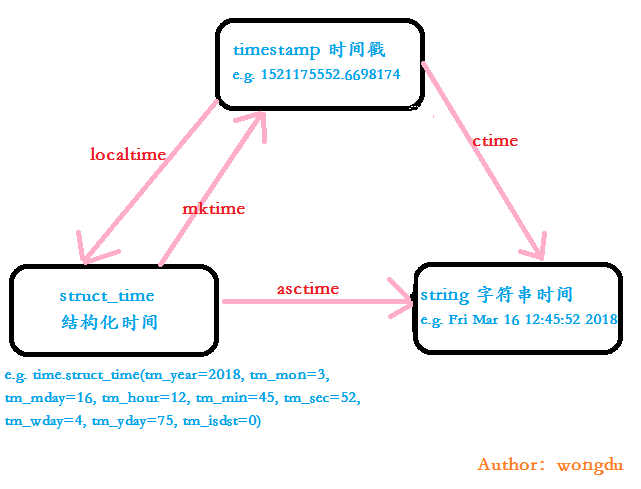Python time&datetime模块
1.time&datetime模块
time&datetime是时间模块,常用以处理时间相关问题
time.time() #返回当前时间的时间戳timestamp time.sleep() #睡眠时间,默认秒 time.gmtime() #时间戳转换成UTC时间的struct_time time.localtime() #时间戳转换成返回本地时间的struct_time time.asctime() #struct_time转换成本地时间的标准化string时间 time.ctime() #时间戳转换成本地时间的标准化string时间 time.mktime() #struct_time转换成本地时间的时间戳timestamp time.strftime() #解析struct_time,自定义格式化显示时间 time.strptime() #解析格式化时间,返回struct_time
常用功能使用说明

# -*- coding:utf-8 -*- # Author:Wong Du ''' time&datetime是时间模块, 常用以处理时间相关问题 ''' import time ''' time模块时间的3种形式 1.timestamp 时间戳 e.g. 1521164794.9068174 2.struct_time 结构化时间(元组形式表示) e.g. time.struct_time(tm_year=2078, tm_mon=6, tm_mday=25, tm_hour=22, tm_min=57, tm_sec=22, tm_wday=5, tm_yday=176, tm_isdst=0) 3.string_time 字符串表示(时间的人性化显示,一般人类可读) e.g. Fri Mar 16 09:49:13 2018 ''' # 时间戳 print(time.time()) # 结构化 print(time.localtime()) # 字符串 print(time.asctime()) # time.asctime(p_tuple=None) --> string, # 解析一个tuple结构化时间,返回其标准化时间的string,如:Fri Mar 16 09:51:26 2018, # 若tuple为空,则返回当前时间的string m = (2018, 3, 16, 10, 0, 52, 4, 75, 0) print(time.asctime(m)) # time.ctime(seconds=None) --> string, # 时间戳转化成标准化时间的string,若seconds为空, # 则返回当前时间的string print(time.ctime(2222222222)) # time.gmtime(seconds=None) --> struct_time, # 时间戳转换成UTC时间的struct_time,和中国时间差8个小时 # 若seconds为空,则返回当前UTC时间的struct_time print(time.gmtime(2222222)) # time.localtime(seconds=None) --> struct_time, # 时间戳转换成struct_time, # 若seconds为空,则返回当前的struct_time print(time.localtime(2222222)) # time.mktime(p_tuple) --> timestamp # 把struct_time转换成时间戳timestamp, print(time.mktime(m)) # 获取本地当前时间的时间戳 print(time.time()) # 设置睡眠时间,单位秒 time.sleep(0.1) # time.strftime(format,p_tuple=None) --> format_time # 解析p_tuple,自定义格式显示,如:2018-01-03, # 若p_tuple为空,则格式化显示本地当前时间 print(time.strftime("%Y-%m-%d %H:%M:%S",m)) # time.strptime(string,format) --> struct_time, # 解析string,获取到string表示的struct_time print(time.strptime("2018-1-1","%Y-%m-%d")) import datetime # 获取本地当前时间,格式: %Y-%m-%d %H:%M:%S print(datetime.datetime.now()) # 时间加减,默认顺序:days,秒,微秒,毫秒,minutes,hours,weeks print(datetime.datetime.now() + datetime.timedelta(1)) #+1day print(datetime.datetime.now() + datetime.timedelta(-3)) #-3day print(datetime.datetime.now() + datetime.timedelta(minutes=-10)) #-10minutes print(datetime.datetime.now() + datetime.timedelta(weeks=1)) #+7day # 时间替换 """ replace(self, year=None, month=None, day=None, hour=None, minute=None, second=None, microsecond=None, tzinfo=True) """ print(datetime.datetime.now().replace(year=2022))
其他
时间格式化显示: %Y Year with century as a decimal number. %m Month as a decimal number [01,12]. %d Day of the month as a decimal number [01,31]. %H Hour (24-hour clock) as a decimal number [00,23]. %M Minute as a decimal number [00,59]. %S Second as a decimal number [00,61]. %z Time zone offset from UTC. %a Locale's abbreviated weekday name. %A Locale's full weekday name. %b Locale's abbreviated month name. %B Locale's full month name. %c Locale's appropriate date and time representation. %I Hour (12-hour clock) as a decimal number [01,12]. %p Locale's equivalent of either AM or PM.
三种时间格式关系示例图

静静的学习一阵子儿...





